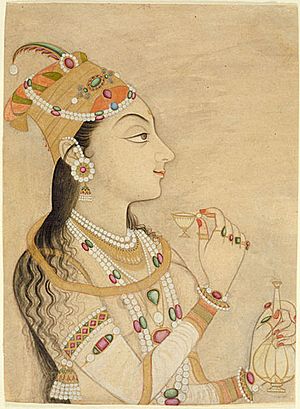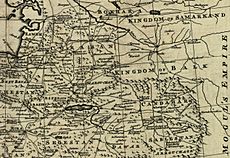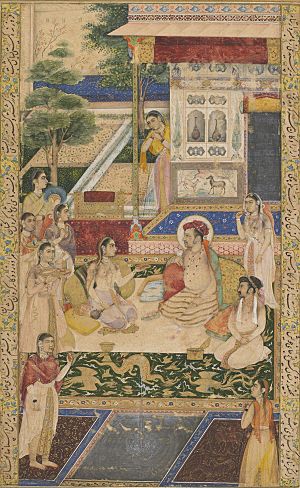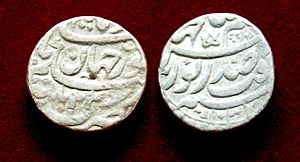Nur Jahan facts for kids
Quick facts for kids Nur Jahan |
|
|---|---|
| Empress consort of the Mughal Empire | |

Idealised portrait of the Mughal Empress Nur Jahan c. 1627
|
|
| Padshah Begum | |
| Tenure | June 1620 – 28 October 1627 |
| Predecessor | Saliha Banu Begum |
| Successor | Mumtaz Mahal |
| Born | Mehr-un-Nissa c. 1577 Kandahar, Safavid Empire (present-day Afghanistan) |
| Died | 17 December 1645 (aged 68) Lahore, Mughal Empire (present-day Pakistan) |
| Burial | Tomb of Nur Jahan, Lahore |
| Spouse |
|
| Issue | Ladli Begum |
| House | Timurid (by marriage) |
| Father | Mirza Ghiyas Beg |
| Mother | Asmat Begum |
| Religion | Shia Islam |
Nur Jahan, originally named Mehr-un-Nissa, was a powerful and influential empress of the Mughal Empire. She was the twentieth wife and chief queen of the Mughal emperor Jahangir.
Many historians believe that Nur Jahan was the true ruler of the empire for over ten years. She had a lot of power and influence, more than any other Mughal empress before or after her. She even had coins made with her name on them! Her husband Jahangir often had poor health, which allowed her to take on a very important role in leading the empire.
Contents
Early Life and Family (1577–1594)
Nur Jahan was born in 1577 in Kandahar, which is now part of Afghanistan. Her birth name was Mehr-un-Nissa. She came from a noble Persian family. Her parents were Mirza Ghiyas Beg and Asmat Begum.
Her family faced hard times in Persia. So, they decided to move to India. They hoped to find better opportunities at the court of Emperor Akbar. On their journey, robbers attacked them and took their belongings.
When they reached Kandahar, Nur Jahan's mother gave birth to her. The family was very poor and worried about taking care of the new baby. Luckily, a kind merchant named Malik Masud helped them. He later helped Nur Jahan's father get a job with Emperor Akbar. Because her birth seemed to bring good luck, she was named Mehr-un-Nissa, which means 'Sun among Women'.
Her father, Ghiyas Beg, quickly became an important official. He was known for his excellent business skills. The emperor gave him the title Itimad-ud-Daula, meaning ‘Pillar of the State’. Thanks to her father's success, Nur Jahan received a great education. She learned Arabic and Persian, art, literature, music, and dance. She was known for being very intelligent and having good common sense.
First Marriage to Sher Afgan (1594–1607)
In 1594, when Nur Jahan was 17, she married her first husband, Ali Quli Istajlu. He was also known as Sher Afgan Khan. Sher Afgan was a brave Persian soldier. He joined the Mughal army and served under Emperors Akbar and Jahangir.
Emperor Akbar arranged Nur Jahan's marriage to Sher Afgan as a reward for his service. In 1605, they had a daughter named Ladli Begum. Sher Afgan earned his title, "Tiger Tosser," during a military campaign. This was because he was said to have saved Prince Salim (who later became Emperor Jahangir) from a tiger.
In 1607, Sher Afgan died. There were rumors that he had refused to obey the governor of Bengal and attacked him. Some people thought Emperor Jahangir might have wanted Sher Afgan dead because he was interested in Nur Jahan. However, Jahangir only married Nur Jahan four years later, in 1611. Historians are not sure if a love story existed before then.
Life as Mughal Empress
Lady-in-Waiting to Ruqaiya Sultan Begum (1607–1611)
After Sher Afgan died in 1607, Nur Jahan and her daughter, Ladli Begum, were called to Agra. Emperor Jahangir wanted to protect them. Nur Jahan became a lady-in-waiting to Ruqaiya Sultan Begum. Ruqaiya was one of the main wives of the late Emperor Akbar.
It was important for Nur Jahan to be at the Mughal court for her safety. Her father's high position also helped. She was able to spend time with her parents and visit the emperor's women. Nur Jahan served Ruqaiya Sultan Begum for four years. They had a very close and loving relationship. A Dutch traveler named Pieter van den Broecke wrote that Ruqaiya loved Nur Jahan very much and always kept her close.
Marriage to Jahangir (1611–1627)
Nur Jahan and Jahangir's relationship has many stories and legends. Some stories say they were in love before Nur Jahan's first marriage. But modern historians doubt this.
In 1611, Nur Jahan met Emperor Jahangir at a special market during the spring festival of Nowruz. Jahangir proposed to her right away. They were married on May 25, 1611. Nur Jahan was 34 years old. She became Jahangir's twentieth and last legal wife. Some records say they had two children, while others say they had none.
Jahangir gave her the title Nur Mahal (Light of the Palace) when they married. Five years later, in 1616, he changed it to Nur Jahan (Light of the World). Jahangir trusted Nur Jahan deeply. He gave her his imperial seal, which meant her approval was needed for any official document. For many years, she held great power and was seen as the real force behind the Mughal throne.
Jahangir also entrusted her with his grandson, Prince Shah Shuja, when he was born in 1616. This showed her high rank and the emperor's affection for her.
Family Influence and Power
After her first husband's death, Nur Jahan's family was not in a very high position. But when she married Jahangir, things changed. The Mughal emperor had absolute power, and those who influenced him gained great prestige. Nur Jahan convinced Jahangir to pardon her father and make him Prime Minister.
To make her family even stronger, Nur Jahan placed many relatives in important court jobs. Her brother, Asaf Khan, became the grand minister to Jahangir. She also arranged for her daughter, Ladli Begum, to marry Jahangir's youngest son, Shahryar. This marriage helped ensure her family's influence would continue in the Mughal Empire.
Leading the Mughal Empire
Nur Jahan was a skilled hunter. She often went on hunting trips with her husband. She was known for her bravery, even killing four tigers with six bullets during one hunt!
Her leadership skills were very important when her husband was away. She protected the empire's borders and managed family disagreements. She also dealt with rebellions and a fight for the throne when Jahangir did not name an heir before he died in 1627.
In 1626, Emperor Jahangir was captured by rebels. Nur Jahan bravely rode into battle on a war elephant to free him. She ordered her ministers to attack the enemy. Even when her elephant was hit, she surrendered to the rebel leader to be with her husband. But Nur Jahan was very clever. She soon planned an escape and raised an army right under the rebel leader's nose!
Shortly after being rescued, Jahangir died on October 28, 1627.
Maintaining Power and Challenges
After Jahangir's health declined, Nur Jahan tried to secure her power. She wanted her daughter, Ladli Begum, to marry Khusrau Mirza, who was popular. But he refused. Then she offered the marriage to Prince Khurram (who would become Shah Jahan), but he also refused. Finally, her daughter married Prince Shahryar.
Nur Jahan and Prince Khurram (Shah Jahan) did not get along well. Prince Khurram disliked Nur Jahan's influence over his father. He also felt that she favored his half-brother, Shahryar. When the Persians attacked Kandahar, Nur Jahan was in charge. She asked Prince Khurram to lead the army there, but he refused. He feared that if he left, Nur Jahan would try to convince Jahangir to name Shahryar as the next emperor.
Because Prince Khurram refused, Kandahar was lost to the Persians. This fear led Prince Khurram to rebel against his father and Nur Jahan in 1622. His rebellion was stopped, and he was forgiven. But the tension between Nur Jahan and her stepson continued.
When Jahangir died in 1627, a war for the throne began between his sons. Nur Jahan supported Shahryar because she believed she could influence him more easily. However, Nur Jahan's own brother, Asaf Khan, sided with Shah Jahan. Asaf Khan put Nur Jahan under house arrest. Shah Jahan defeated Shahryar's troops and became the new Mughal emperor in 1628.
Later Years and Passing (1628–1645)

After Shah Jahan became emperor, Nur Jahan was placed under house arrest in Lahore. She spent the rest of her life there with her widowed daughter, Ladli Begum, and her granddaughter. They lived a simple life.
Shah Jahan gave her an annual payment. During this time, she oversaw the completion of her father's tomb in Agra. This tomb, known as Itmad-ud-Daulah's tomb, was started in 1622. It later inspired the design of the famous Taj Mahal, which began construction in 1632. Nur Jahan passed away on December 17, 1645, at the age of 68. She is buried in her own tomb in Shahdara Bagh in Lahore. Her tomb has a simple message: "On the grave of this poor stranger, let there be neither lamp nor rose." Her brother Asaf Khan's tomb is also nearby. Her daughter, Ladli Begum, was buried next to her.
Supporter of Arts and Buildings
Nur Jahan was a great supporter of art and architecture. A Dutch traveler named Pelaert noted that she built many expensive buildings. These included "sarais" (resting places for travelers and merchants), beautiful gardens, and palaces. In 1620, she ordered a large "sarai" to be built in the Jalandhar district. It was so important that people called it "Serai Noor Mahal."
Tomb of Itimad-ud-Daulah
Nur Jahan is generally credited with building the tomb for her father, Itimad-ud-Daulah, who died in 1622. The tomb took six years to finish (1622-1628) and cost a lot of money. It was built in her father's garden, across the Yamuna River from Agra. The building is square, with four towers at each corner. Inside, the main room holds the tombs of her father and mother, Asmat Begum. The walls are decorated with beautiful paintings. This tomb is known for its early use of pietra dura, a technique of inlaying cut and fitted polished stones to create images. Nur Jahan also built the Pattar Masjid in Srinagar and her own tomb in Lahore.
Textiles and Fashion
Many stories say that Nur Jahan contributed to almost every type of art and craft. She is said to have introduced new types of textiles. These include badla (silver-threaded brocade) and kinari (silver-threaded lace).
Nur Jahan was very creative and had a great sense of fashion. She is credited with designing many textile materials and dresses. These include the nurmahali dress and fine cloths like Panchtoliya.
See also
 In Spanish: Nur Jehan para niños
In Spanish: Nur Jehan para niños
- Achabal Gardens
- Serai Nurmahal
- Tomb of I'timād-ud-Daulah
- Panchtoliya
- Nurmahali Dress





